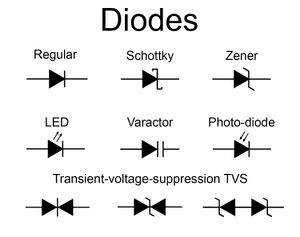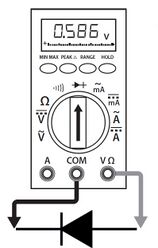More actions
No edit summary |
No edit summary |
||
| Line 34: | Line 34: | ||
===Types=== | ===Types=== | ||
Diodes come in different physical cases that are either SMD or THT they can look identical but have different properties, outlined below is the different types of diodes. | |||
====Regular/Rectifier Diodes==== | ====Regular/Rectifier Diodes==== | ||
| Line 50: | Line 51: | ||
====Varactor Diodes==== | ====Varactor Diodes==== | ||
Varactor diodes, also known as varicap diodes, are used in tuning and frequency modulation applications due to their ability to change capacitance with a varying reverse bias voltage. | Varactor diodes, also known as varicap diodes, are used in tuning and frequency modulation applications due to their ability to change capacitance with a varying reverse bias voltage. Rarely used in consumer electronics today. | ||
====Photo-diodes==== | ====Photo-diodes==== | ||
Revision as of 20:17, 3 November 2023
This article is a stub. You can help Repair Wiki grow by expanding it
| Diodes - Repair Basics | |
|---|---|
| Type | Component |
| Device(s) | Diodes |
| Difficulty | ◉◌◌◌ Easy |
This article aims to provide a comprehensive overview of diodes from a repair perspective, detailing their function, types, common issues, testing methods, and replacement considerations.

What is a Diode?
A diode is a fundamental semiconductor device commonly found in electronic circuits. Its primary function is to allow the flow of electric current in one direction while blocking it in the opposite direction. This property makes diodes useful for rectifying alternating current (AC) into direct current (DC), protecting circuits from reverse voltage, and more.
Diodes have different characteristics found in their datasheets, the most important value when measuring is the forward voltage drop in "Volts"
Diodes are typically identified by the symbols shown in Figure 1 and are usually denoted with the letter D followed by an identifier number. (E.g., D38)
Function
Diodes serve various functions in electronic circuits, with the most common being:
One way path
The most basic function of a diode is to serve as a unidirectional pathway for the flow of electrical current.
Rectification
Diodes are frequently used to convert AC voltage to DC voltage. They allow the current to flow during the positive half-cycle of the AC signal and block it during the negative half-cycle, effectively converting the signal to a unidirectional flow.
Voltage Regulation
Zener diodes, a specific type of diode, are used to regulate voltage. They maintain a constant voltage across their terminals despite changes on the supply voltage, making them suitable for reference voltage used in power supplies and protecting sensitive components from voltage spikes.
Protection
TVS and Zener diodes are often used to protect sensitive components from voltage spikes and reverse voltage by blocking or clamping excessive voltage levels, serving as surge protectors and fly-back diodes in relays and inductive loads.
Photodetection
Photodiodes are used to convert light into electrical signals, making them valuable in various applications, including optical communication, light sensors, and photovoltaic cells in solar panels.
Types
Diodes come in different physical cases that are either SMD or THT they can look identical but have different properties, outlined below is the different types of diodes.
Regular/Rectifier Diodes
Regular or rectifier diodes are the most common type of diodes. Mainly used for converting AC to DC. They come in various package types and sizes.
If used to rectify mains AC to DC, you'll typically find 4 didoes in full bridge configuration in one package.
Schottky Diodes
Schottky diodes are known for their fast switching speed and low forward voltage drop. They are used in high-frequency applications and as rectifiers in power supplies.
Zener Diodes
Zener diodes are designed to maintain a constant voltage across their terminals when operated in the reverse-biased breakdown region. They are used for voltage regulation and are often labeled with their nominal voltage value.
Light Emitting Diodes (LEDs)
LEDs are a specialized type of diode that emits light when forward-biased. They are commonly used in displays, indicators, and lighting applications.
Varactor Diodes
Varactor diodes, also known as varicap diodes, are used in tuning and frequency modulation applications due to their ability to change capacitance with a varying reverse bias voltage. Rarely used in consumer electronics today.
Photo-diodes
Photodiodes are light-sensitive diodes that produce a current in response to incident light. They are used in light detection and optical communication systems.

Testing a Diode
Testing a diode can help determine if it is functioning correctly. Most diodes can be tested using a digital multimeter in diode test mode. It's best to test the diode outside the circuit.
Regular / Schottky / Zener / LED
- Identify the anode and cathode terminals of the diode. The cathode is typically marked with a band or line on the diode's body.
- Set your multimeter to the diode test mode (usually indicated by a diode symbol).
- Place the red probe on the anode and the black probe on the cathode.
- The multimeter should display a voltage drop reading (around 0.2 to 0.7 V for silicon diodes). If it shows "OL" or less than 0.2, the diode is likely faulty.
- Polarity is a concern. If the diode has a reading when the probes are flipped that means the diode is faulty
You can test the diode in-circuit, but keep in mind that other components in the circuit may affect the measurement but only lowering it.
Identifying a Zener diode's zener voltage
- Remove the diode from the circuit.
- Solder a 1 Kilo Ohm resistor in series with the Zener diode, connecting it to the anode terminal, for example.
- Using a Lab-Bench Power Supply, connect the positive terminal to the cathode of the diode and the negative terminal to the other end of the resistor.
- Place your multimeter in DC voltage mode and connect its probes across the diode.
- Gradually increase the power supply voltage until the reading on your multimeter no longer rises.
- The voltage at which the multimeter reading plateaus represents the Zener voltage for this diode.
Replacement Considerations
When replacing a diode, always read the datasheets and pay attention to the following parameters:
- Type: Ensure the replacement diode is of the same type and has similar electrical characteristics as the faulty diode.
- Forward Voltage: Match the forward voltage rating closely to the original diode. Using a diode with a significantly different forward voltage may affect circuit performance.
- Reverse Voltage (Zener): Pay attention to the reverse voltage rating. That's the most important parameter for Zener diodes.
- Power Rating: Match or exceed the power rating of the replacement diode with the original diode.
- Package Type: Choose a replacement diode with a compatible package type and size. Different packages have different mounting and pin configurations. If space is not a concern, you can use any size as it won't affect the circuit behavior.
- Reverse Recovery Time: In high-frequency applications, the reverse recovery time of the diode is crucial. Ensure the replacement diode has a similar or faster reverse recovery time.
Replacing a diode with the wrong specifications can lead to circuit malfunctions or failure, so it's essential to choose a replacement carefully.
